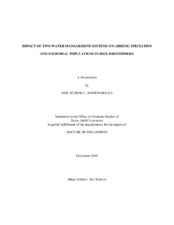| dc.contributor.advisor | Gentry, Terry | |
| dc.contributor.advisor | Loeppert, Richard | |
| dc.creator | Somenahally, Anil Kumar C. | |
| dc.date.accessioned | 2012-02-14T22:18:01Z | |
| dc.date.accessioned | 2012-02-16T16:16:10Z | |
| dc.date.available | 2012-02-14T22:18:01Z | |
| dc.date.available | 2012-02-16T16:16:10Z | |
| dc.date.created | 2010-12 | |
| dc.date.issued | 2012-02-14 | |
| dc.date.submitted | December 2010 | |
| dc.identifier.uri | https://hdl.handle.net/1969.1/ETD-TAMU-2010-12-8620 | |
| dc.description.abstract | Arsenic (As) is a problem with rice production systems throughout the world as high As
concentrations are reported in rice grains originating from several parts of the world. This
characteristic is mainly due to the flooded conditions utilized in rice culture. We hypothesized
that the soluble As concentrations in the rice rhizosphere can be decreased by growing rice more
aerobically through intermittent flooding. Intermittent water management practices might also
change microbial populations in the rice rhizosphere that might potentially impact As chemistry
and bioavailability. Two field-scale experiments were conducted over two years to study the
impact of intermittent and continuous flooding on As speciation and microbial populations in the
rice rhizosphere. As levels and speciation in the rhizosphere soil, root-plaque and pore-water
were determined using a high performance liquid chromatography-inductively coupled plasmamass
spectroscopy (HPLC-ICP-MS). The microbial populations were assessed from the
rhizosphere soil and root-plaque samples using quantitative polymerase chain reaction (qPCR)
and 16S rRNA sequencing. Pore-water and root-plaque total-As concentrations significantly
decreased in the intermittent compared to the continuous flood plots. Inorganic arsenite (iAsIII)
was predominant in pore-water and inorganic arsenate (iAsV) in root-plaque and soil. Rootplaque sequestered significantly higher levels of As (almost tenfold higher) than the adjacent
rhizosphere soil. Grain As concentrations also decreased by 35 to 45 percent in the intermittent
compared to the continuously flooded plots. Organic As species, monomethyl and dimethyl
arsenate were detected in the rhizosphere with relative increases and decreases among the
treatments. Bacteria were the predominant group (91 to 94 percent and 48 to 78 percent of total community
in root-plaque and rhizosphere soils, respectively). Archaea were also a major component of
rhizosphere soil with their populations being higher under continuous flooding. The relative
abundance of iron-reducing bacteria was around 3 to 6 percent of the total community in root-plaque
and around 6 to 6 percent in soil, with significantly lower abundance in the intermittent compared to
the continuously flooded plots. Results of these studies demonstrated that intermittent flooding
could be a potential management option to reduce grain As in rice cultivated on fields with
moderate to high As concentrations. | en |
| dc.format.mimetype | application/pdf | |
| dc.language.iso | en_US | |
| dc.subject | Rice rhizosphere | en |
| dc.subject | Arsenic speciation | en |
| dc.subject | Microbial populations | en |
| dc.subject | qPCR | en |
| dc.subject | pyrosequencing | en |
| dc.title | Impact of Two Water Management Systems on Arsenic Speciation and Microbial Populations in Rice Rhizosphere | en |
| dc.type | Thesis | en |
| thesis.degree.department | Soil and Crop Sciences | en |
| thesis.degree.discipline | Soil Science | en |
| thesis.degree.grantor | Texas A&M University | en |
| thesis.degree.name | Doctor of Philosophy | en |
| thesis.degree.level | Doctoral | en |
| dc.contributor.committeeMember | Senseman, Scott | |
| dc.contributor.committeeMember | Autenrieth, Robin | |
| dc.contributor.committeeMember | DeLaune, Paul | |
| dc.type.genre | thesis | en |
| dc.type.material | text | en |


